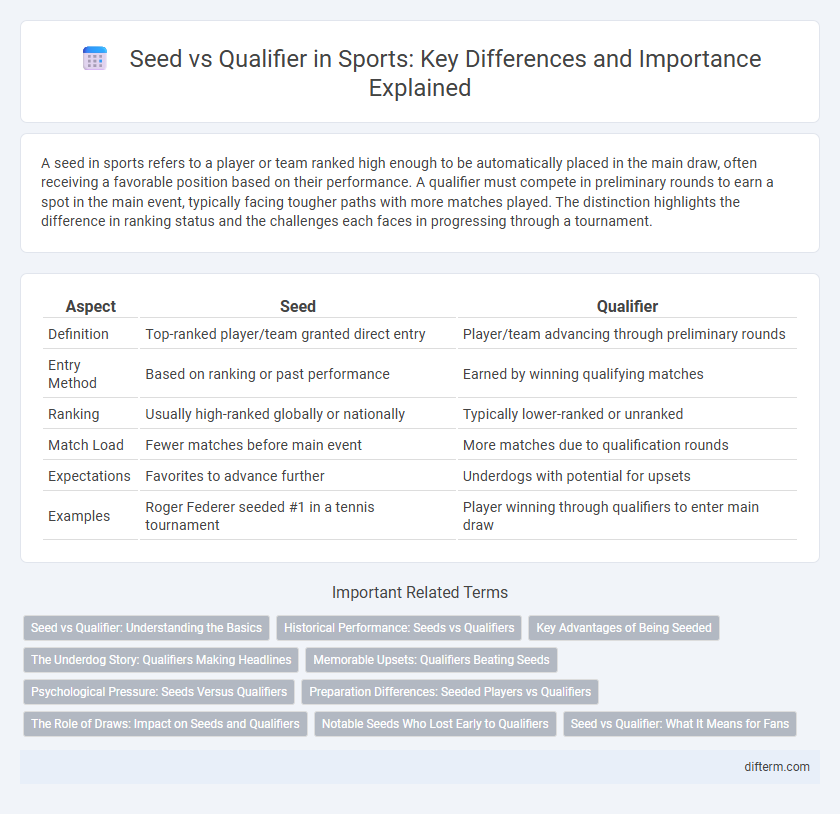A seed in sports refers to a player or team ranked high enough to be automatically placed in the main draw, often receiving a favorable position based on their performance. A qualifier must compete in preliminary rounds to earn a spot in the main event, typically facing tougher paths with more matches played. The distinction highlights the difference in ranking status and the challenges each faces in progressing through a tournament.
Table of Comparison
| Aspect | Seed | Qualifier |
|---|---|---|
| Definition | Top-ranked player/team granted direct entry | Player/team advancing through preliminary rounds |
| Entry Method | Based on ranking or past performance | Earned by winning qualifying matches |
| Ranking | Usually high-ranked globally or nationally | Typically lower-ranked or unranked |
| Match Load | Fewer matches before main event | More matches due to qualification rounds |
| Expectations | Favorites to advance further | Underdogs with potential for upsets |
| Examples | Roger Federer seeded #1 in a tennis tournament | Player winning through qualifiers to enter main draw |
Seed vs Qualifier: Understanding the Basics
A seed in sports tournaments is a player or team ranked and placed strategically to avoid facing other top-ranked opponents early, ensuring balanced competition. Qualifiers are competitors who earn their spot through preliminary rounds, often unseeded and facing tougher early matches. Understanding the dynamics between seeds and qualifiers highlights the challenges qualifiers face and the advantages seeds hold in progressing through the tournament.
Historical Performance: Seeds vs Qualifiers
Seeds have traditionally dominated major tournaments, leveraging higher rankings and consistent performance to advance further in draws compared to qualifiers. Data from Grand Slam events reveal that seeded players reach quarterfinals or beyond at a significantly higher rate, while qualifiers often face early-round exits due to lower rankings and less experience. However, historical upsets by qualifiers, such as Emma Raducanu's 2021 US Open win, highlight the potential for breakthrough performances that challenge seeding predictions.
Key Advantages of Being Seeded
Being seeded in sports tournaments offers the key advantage of a more favorable draw, reducing the likelihood of facing other top competitors in early rounds. Seeds often benefit from increased rest periods and strategic match scheduling, enhancing performance potential. This positioning reflects superior ranking and form, providing psychological confidence and better preparation opportunities compared to qualifiers.
The Underdog Story: Qualifiers Making Headlines
Qualifiers often defy expectations by defeating higher-seeded players, showcasing resilience and skill that captivate sports fans worldwide. Their underdog stories generate significant media attention, highlighting the unpredictable nature of tournaments and inspiring aspiring athletes. These unexpected victories emphasize the competitive depth and excitement within professional sports.
Memorable Upsets: Qualifiers Beating Seeds
Qualifiers defeating seeded players in major tournaments create some of the most memorable upsets in sports history, showcasing the unpredictable nature of competition. These victories often highlight the depth of talent and the intensity of qualification rounds, where lower-ranked athletes gain momentum and confidence. Iconic matches, such as the 2012 US Open where John Isner faced qualifier Philippe-Chatrier, exemplify how qualifiers can disrupt expectations and redefine rankings.
Psychological Pressure: Seeds Versus Qualifiers
Seeds experience intense psychological pressure due to high expectations and the burden of maintaining their ranking, often leading to anxiety and performance stress. Qualifiers typically face less external pressure, allowing them to play with greater freedom and confidence, which can result in surprising upsets. The mental resilience of qualifiers often provides a competitive edge during high-stakes matches against seeded players.
Preparation Differences: Seeded Players vs Qualifiers
Seeded players benefit from direct entry into main draws, allowing focused training and strategic match preparation without exhausting early rounds. Qualifiers face intense physical and mental demands during preliminary matches, often improving match sharpness but risking fatigue before main competition. This contrast in preparation affects stamina management, tactical readiness, and psychological resilience differently for seeded players and qualifiers.
The Role of Draws: Impact on Seeds and Qualifiers
Draws in sports tournaments critically influence the progression of seeds and qualifiers by determining initial matchups and potential pathways. Seeded players typically gain advantageous positions based on rankings, which can provide smoother advancement, while qualifiers often face more challenging early rounds due to lower rankings and unpredictable opponents. The configuration of the draw affects competitive balance, influencing the likelihood of upsets and shaping the overall tournament dynamics.
Notable Seeds Who Lost Early to Qualifiers
Notable seeds such as Roger Federer at Wimbledon 2013 and Serena Williams at the 2017 Australian Open fell early to qualifiers, shocking fans and analysts alike. These upsets highlight the increasing depth in tennis, where lower-ranked players from qualifying rounds demonstrate strong potential against top-seeded opponents. Early exits by big seeds intensify tournament unpredictability and showcase the evolving competitiveness within professional tennis.
Seed vs Qualifier: What It Means for Fans
Seed players enter tournaments with higher rankings, often facing theoretically easier opponents in early rounds, creating expectations for strong performances. Qualifiers battle through preliminary matches to secure their spot, bringing unpredictable energy and potential upsets that excite fans. This dynamic intensifies tournament narratives, offering viewers a mix of anticipated skill displays and surprise victories.
seed vs qualifier Infographic

 difterm.com
difterm.com